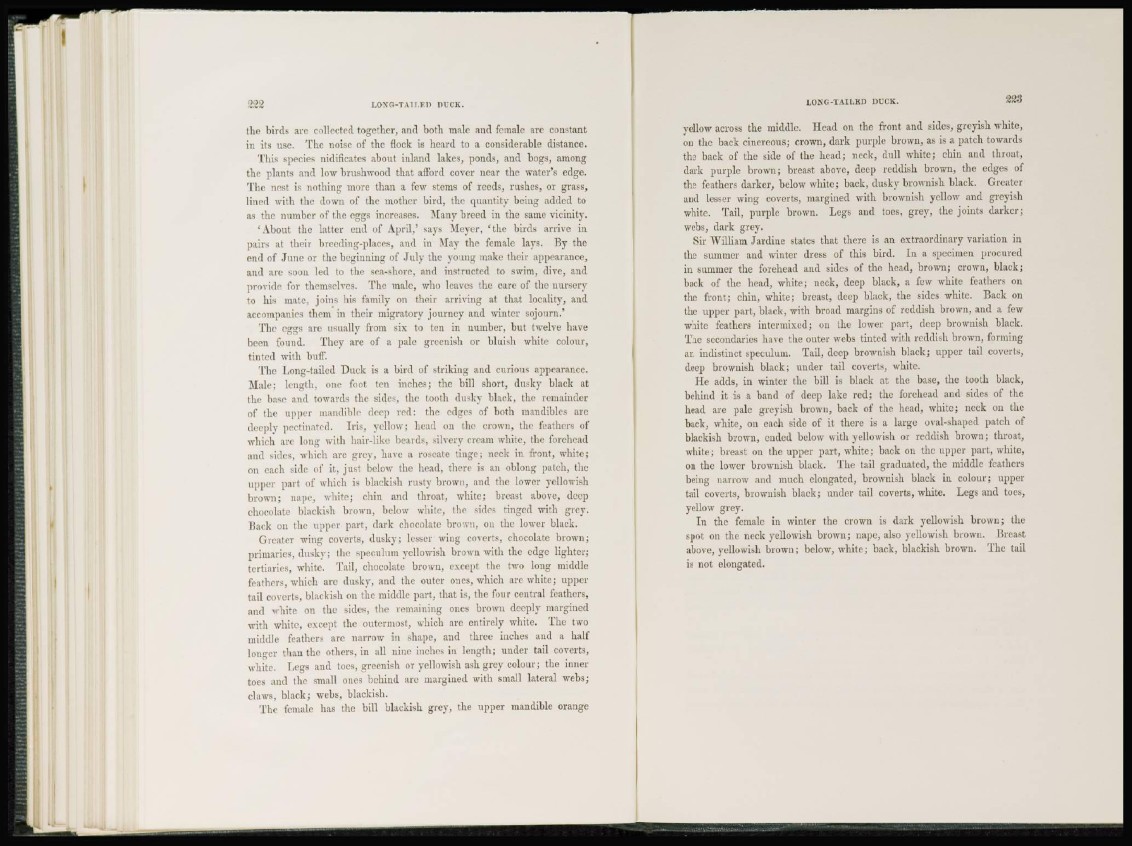
the birds are collected together, and both male and female are constant
in its use. The noise of the flock is heard to a considerable distance.
This species nidificates about inland lakes, ponds, and bogs, among
the plants and low brushwood that afford cover near the water's edge.
The nest is nothing more than a few stems of reeds, rushes, or grass,
lined with the down of the mother bird, the quantity being added to
as the number of the eggs increases. Many breed in the same vicinity.
'About the latter end of April,' says Meyer, ' t h e birds arrive in
pairs at their breeding-places, and in May the female lavs. By the
end of June or the beginning of July the voting make their appearance,
and are soon led to the sea-shore, and instructed to swim, dive, and
provide for themselves. The male, who leaves the care of the nursery
to his mate, joins Ins family on their arriving at that locality, and
accompanies them in their migratory journey and winter sojourn.'
The eggs are usually from six to ten in number, but twelve have
been found. They are of a pale greenish or bluish white colour,
tinted with buff.
The Long-tailed Duck is a bird of striking and curious appearance.
Male; length, one foot ten inches; the bill short, dusky black at
the base and towards the sides, the tooth dusky black, the remainder
of the upper mandible deep red: the edges of both mandibles are
deeply pectinated. Iris, yellow: head on the crown, the feathers of
which are long with hair-like beards, silvery cream white, the forehead
and sides, which arc grey, have a roseate tinge; neck in front, white;
on each side of it, just below the head, there is an oblong patch, the
upper part of which is blackish rusty brown, and the lower yellowish
brown; nape, white; chin and throat, white; breast above, deep
chocolate blackish brown, below white, the sides tinged with grey.
Back on the upper part, dark chocolate brown, on the lower black.
Greater wing coverts, dusky; lesser wing coverts, chocolate brown;
primaries, dusky; the speculum yellowish brown with the edge lighter;
tertiaries, white. Tail, chocolate brown, except the two long middle
feathers, which arc dusky, and the outer ones, which are white; upper
tail coverts, blackish on the middle part, that is, the four central feathers,
and white on the sides, the remaining ones brown deeply margined
with white, except the outermost, which are entirely white. The two
middle feathers are narrow in shape, and three inches and a half
longer than the others, in all nine inches in length; under tail coverts,
white. Legs and toes, greenish or yellowish ash grey colour; the inner
toes and the small ones behind are margined with small lateral webs;
claws, black; webs, blackish.
The female has the bill blackish grey, the upper mandible orange
yellow across the middle. Head on the front and sides, greyish white,
on the back cinereous; crown, dark purple brown, as is a patch towards
the back of the side of the head; neck, dull white; chin and throat,
dark purple brown; breast above, deep reddish brown, the edges of
the feathers darker, below white; back, dusky brownish black. Greater
and lesser wing coverts, margined with brownish yellow and greyish
white. Tail, purple brown. Legs and toes, grey, the joints darker;
webs, dark grey.
Sir William Jardine states that there is an extraordinary variation in
the summer and winter dress of this bird. In a specimen procured
in summer the forehead and sides of the head, brown; crown, black;
back of the head, white; neck, deep black, a few white feathers on
the front; chin, white; breast, deep black, the sides white. Back on
the upper part, black, with broad margins of reddish brown, and a few
white feathers intermixed; on the lower part, deep brownish black.
The secondaries have the outer webs tinted with reddish brown, forming
an indistinct speculum. Tail, deep brownish black; upper tail coverts,
deep brownish black; under tail coverts, white.
He adds, in winter the bill is black at the base, the tooth black,
behind it is a band of deep lake red; the forehead and sides of the
head are pale greyish brown, back of the head, white; neck on the
back, white, on each side of it there is a large oval-shaped patch of
blackish brown, ended below with yellowish or reddish brown; throat,
white; breast on the upper part, white; back on the upper part, white,
on the lower brownish black. The tail graduated, the middle feathers
being narrow and much elongated, brownish black in colour; upper
tail coverts, brownish black; under tail coverts, white. Legs and toes,
yellow grey.
I n the female in winter the crown is dark yellowish brown; the
spot on the neck yeUowish brown; nape, also yellowish brown. Breast
above, yeUowish brown; below, white; back, blackish brown. The tail
is not elongated.